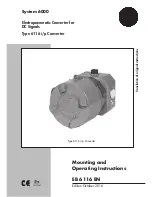
WAVECOM Decoder W74PC, W-PCI/e, W-CODE, W-CLOUD Manual V9.1.0
Transmission Modes
129
Parameter
Value
Input format(s)
AF, IF
Additional Info
ITA-5
For ASCII mode standard baud rates from 110 to 300 Baud are available. Non-standard baud rates may
be selected using the
Baudrate
menu item.
The parity bit allows error detection. The number of "1"s is counted. If an odd number is found and parity
has been defined as ODD, then the parity bit should be "1", otherwise an error has occurred. If parity has
been defined as EVEN and an even number of "1"s is found, then the parity bit should also be "1".
The ASCII code does not distinguish between a "Letters" or "Figures" case as does Baudot because 7 or 8
data bit ASCII has 128 or 256 possible bit combinations. This covers most symbol requirements.
ASCII based transmissions are finding their way into radio data communications because of the compati-
bility with computer communications thus avoiding time and resource consuming code conversions.
From
Options/Frame length
and
Parity
the various code word lengths and parity options may be se-
lected.
Mark parity means that the parity bit is always set to the mark signal condition, and likewise, space parity
always sends the parity bit in the space signal condition. Since these two parity options serve no useful
purpose whatsoever, they are almost never used.
ATIS
ATIS is an abbreviation of "Automatic Transmitter Identification System". ATIS is used in the VHF-UHF ra-
dio systems on the river Rhine and automatically generates the identification signal at the end of each pe-
riod of speech transmission. In case of lengthy transmissions, the ATIS signal is required to be transmitted
at least once every five minutes.
Parameter
Value
Frequency range
VHF/UHF
Operation modes
FEC
Modulation
FM, SUB FSK
Symbol rate
1200 Bd
Center frequency
1700 Hz
Shift
800 Hz
Receiver settings
FM, BW = 12 kHz
Input format(s)
AF, IF
Additional Info
7 Bit decimal code with redundancy
ATIS conforms in certain aspects to the CCITT Recommendation 493-3. The specifications are directed at
all river Rhine nautical radio installations, fixed as well as mobile stations and has been in use there since
1994 and from 1995 also internationally.
The ATIS signal sequence is transmitted using the FSK with space and mark frequencies of 1300 Hz and
2100 Hz and a modulation rate of 1200 Baud. The higher frequency corresponds to the B-state of the sig-
nal and the lower to the Y-state.
The ATIS sequence consists of a country identifier and a four digit call-sign, e.g., PE 1234 for a Dutch ves-
sel or HB 6235 for a Swiss vessel.
All sequences are transmitted twice (DX and RX positions). A 10-bit code is used in this synchronous sys-
tem. Bits 8, 9 and 10 are a binary representation of the number of bits in the B-state. The error check
character corresponds to a modulo-2 sum of the corresponding information bits.
















































